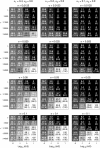Adaptation of a quantitative trait to a moving optimum
- PMID: 17409085
- PMCID: PMC1893041
- DOI: 10.1534/genetics.106.067215
Adaptation of a quantitative trait to a moving optimum
Abstract
We investigate adaptive evolution of a quantitative trait under stabilizing selection with a moving optimum. We characterize three regimes, depending on whether (1) the beneficial mutation rate, (2) the fixation time, or (3) the rate of environmental change is the limiting factor for adaptation. If the environment is rate limiting, mutations with a small phenotypic effect are preferred over large mutations, in contrast to standard theory.
Figures



References
-
- Bello, Y., and D. Waxman, 2006. Near-periodic substitutions and the genetic variance induced by environmental change. J. Theor. Biol. 239: 152–160. - PubMed
-
- Bürger, R., 2000. The Mathematical Theory of Selection, Recombination, and Mutation. Wiley, Chichester, UK.
-
- Crow, J. F., and M. Kimura, 1970. An Introduction to Population Genetics Theory. Harper & Row, New York.
-
- Eaton, J., 1997. GNU Octave Manual, Ed. 3. Network Theory Ltd., Bristol, UK.
-
- Galassi, M., J. Davies, J. Theiler, B. Gough, G. Jungman et al., 2005. GNU Scientific Library Reference Manual, Ed. 2. Network Theory Ltd., Bristol, UK.
Publication types
MeSH terms
LinkOut - more resources
Full Text Sources

